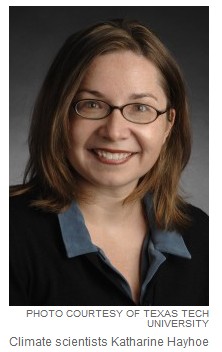Texas summer afternoons have been getting much cooler since 1930, with 100ºF days down 40%.
Index of /pub/data/ghcn/daily/hcn/
Here in West Texas we’re already really dry… so drought is almost the norm for us. But with climate change, what we see is through increasing temperatures and through increasing variability in our precipitation rainfall patterns, we have the potential for even more impacts on water in the future … It’s as if we have two dice and we always have a chance of rolling that double six, which would be that extreme event. But with many of our events – including very high temperature days, extreme heat, and heavy rainfall – climate change has been kind of coming in and removing some of those other numbers off the dice and putting in more sixes … increasing our risk of having one of those [extreme] events.
Climate Change and the Drought: An Interview With Katharine Hayhoe | StateImpact Texas
Hayhoe, Hayhoe, it’s off to spread mindless superstition we go …
[youtube=http://www.youtube.com/watch?v=whnn9ReUV04]
Station name State Station Number ALBANY TX USC00410120 ALPINE TX USC00410174 BALLINGER 2 NW TX USC00410493 BALMORHEA TX USC00410498 BEEVILLE 5 NE TX USC00410639 BLANCO TX USC00410832 BOERNE TX USC00410902 BRENHAM TX USC00411048 BROWNWOOD 2ENE TX USC00411138 CORSICANA TX USC00412019 CROSBYTON TX USC00412121 DANEVANG 1 W TX USC00412266 EAGLE PASS 3N TX USC00412679 ENCINAL TX USC00412906 FALFURRIAS TX USC00413063 FLATONIA 4SE TX USC00413183 GREENVILLE KGVL RADIO TX USC00413734 HALLETTSVILLE 2 N TX USC00413873 HASKELL TX USC00413992 LAMPASAS TX USC00415018 LIBERTY TX USC00415196 LLANO TX USC00415272 LULING TX USC00415429 MARSHALL TX USC00415618 MEXIA TX USC00415869 MIAMI TX USC00415875 MULESHOE #1 TX USC00416135 NEW BRAUNFELS TX USC00416276 PARIS TX USC00416794 PLAINVIEW TX USC00417079 QUANAH 2 SW TX USC00417336 RIO GRANDE CITY TX USC00417622 SEMINOLE TX USC00418201 SNYDER TX USC00418433 STRATFORD TX USC00418692 WEATHERFORD TX USC00419532




http://www.katharinehayhoe.com/bio.php
worth the read to see where she’s coming from.
Guess critical thinking is no longer required to get PhDs.
Parrots have Degrees.
hayhoe has a Hole in her head. I grew up in the Dallas/Fort Worth aera and the Trinity river was always up and down over the years.
Heck back in 1904 it was 6 times lower than today and set a record:
http://tinyurl.com/kdg7nub
The summer afternoons may be getting cooler but when they are hot it’s the wrong kind of heat. Brits would understand.
Most claims that the IPCC models have failed are based on surface temperature changes over the past 15 years (1998–2012). During that period, temperatures have risen about 50 percent more slowly than the multi-model average, but have remained within the range of individual model simulation runs.
However, 1998 represented an abnormally hot year at the Earth’s surface due to one of the strongest El Niño events of the 20th century. Thus it represents a poor choice of a starting date to analyze the surface warming trend (selectively choosing convenient start and/or end points is also known as ‘cherry picking’). For example, we can select a different 15-year period, 1992–2006, and find a surface warming trend nearly 50 percent faster than the multi-model average.
Global surface temperature data 1975–2012 from NASA with a linear trend (black), with trends for 1992–2006 (red) and 1998–2012 (blue).
In short, if David Rose wasn’t declaring that global surface warming was accelerating out of control in 2006, then he has no business declaring that global surface warming has ‘paused’ in 2013. Both statements are equally wrong, based on cherry picking noisy short-term data.
Leftist are nothing if not duplicitous. 😆
So it is wrong to use an abnormally warm start date (1998), but good to use an abnormally cold start date (1975). Got it!
ROFLMAO!!!
The starting date I always see is 1900.
You did not mention 1900 anywhere in your comment. And from your reply it is apparent that you simply parrot what you see and hear. You do not have the capacity for original thought.
Here is the spaghetti graph comparing model temperature “projections” versus the actual temp data: http://wattsupwiththat.files.wordpress.com/2013/06/cmip5-73-models-vs-obs-20n-20s-mt-5-yr-means11.png
Avery, you say, “During that period, temperatures have risen about 50 percent more slowly than the multi-model average,”
I just checked. When you say “risen about 50 percent more slowly”, do you mean “cooled”?
http://woodfortrees.org/plot/hadcrut3vgl/from:1998/to:2012/plot/hadcrut3vgl/from:1998/to:2012/trend
2000 to 2010 was warmer than 1990 to 2000. The rate of surface warming may have been less but warming continued. It is suspected that the rate of warming did not slow but was transferred to the ocean. The warming mechanism did not change. Air temperatures may not be the best judge of what is going on.
and 1850 was the end of the LIttle Ice Age…..what’s your point?
2011 sucked ass.
What about the temperature overnight? Just wondering how much it has increased as cities get larger and larger that is creating UHI. It has been a while since we got single digit temperature deep into Texas which was in 1980s. I remember it very fondly when I lived in Houston… frozen outdoor fish pond that you could walk on…